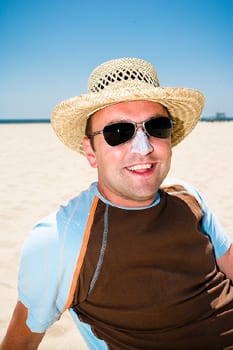 Spring and summer offer many opportunities for fun in the sun, but be aware of the risks of UV radiation. According to the World Health Organization, 60,000 people a year die from prolonged sun exposure around the world (48,000 are from melanoma and 12,000 are from other skin cancers). Skin cancer is the most commonly occurring cancer in the United States and the American Cancer Society estimates that 1.5 million cases of skin cancer will be diagnosed this year. Additionally, most of the more than one million cases of non-melanoma skin cancer diagnosed yearly in the United States are considered to be sun-related.
Spring and summer offer many opportunities for fun in the sun, but be aware of the risks of UV radiation. According to the World Health Organization, 60,000 people a year die from prolonged sun exposure around the world (48,000 are from melanoma and 12,000 are from other skin cancers). Skin cancer is the most commonly occurring cancer in the United States and the American Cancer Society estimates that 1.5 million cases of skin cancer will be diagnosed this year. Additionally, most of the more than one million cases of non-melanoma skin cancer diagnosed yearly in the United States are considered to be sun-related.
You can practice sun-safety every day! The American Cancer Society offers this advice: ”Slip! Slop! Slap!…and Wrap!”
- Slip on a shirt!
Clothes provide different levels of UV protection, depending on many factors. Dark colors generally provide more protection than light colors. A tightly woven fabric protects better than loosely woven clothing. Dry fabric is generally more protective than wet fabric. Some fabrics are even being made that have special coatings to protect from UV rays.
- Slop on sunscreen!
When selecting a sunscreen product, be sure to read the label before you buy. Many groups, including the American Academy of Dermatology, recommend products with a sun protection factor (SPF) of at least 30. The SPF number represents the level of protection against UVB rays provided by the sunscreen — a higher number means more protection.
- Slap on a hat!
A hat with at least a 2- to 3-inch brim all around is ideal because it protects areas such as the ears, eyes, forehead, nose, and scalp that are often exposed to intense sun. A shade cap (which looks like a baseball cap with about 7 inches of fabric draping down the sides and back) also is good, and will provide more protection for the neck. These are often sold in sports and outdoor supply stores.
- Wrap on sunglasses!
The ideal sunglasses do not have to be expensive, but they should block 99% to 100% of UVA and UVB radiation. Check the label to make sure they do. Labels that say “UV absorption up to 400 nm” or “Meets ANSI UV Requirements” mean the glasses block at least 99% of UV rays. Those labeled “cosmetic” block about 70% of the UV rays. If there is no label, don’t assume the sunglasses provide any protection.
A little bit of protection goes a long way in reducing your risk of developing sun-related problems. Follow these steps and have fun in the sun!

